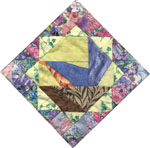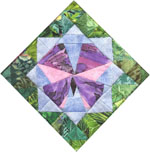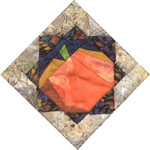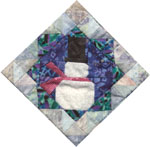



using the book, PIECES: A YEAR IN POEMS AND QUILTS
Value is the darkness or lightness of a color in relation to other colors. Black has the darkest value, white the lightest.
Light colors are said to have high value. Colors such as yellow, yellow-orange, yellow green, and light tints of other colors have high value. (A tint is a color mixed with white.) Colors with high value are light, not heavy, and tend to float.
Dark colors are said to have low value. Colors with low value are violet, purple and dark shades of the other colors. (A shade is a color mixed with black.) Colors with low value are heavy and want to sink.
Red, orange, blue and green are medium values, unless they are mixed with white or other light colors to make them light, or mixed with black or dark colors to make them dark.
Colors can be lighter or darker in value, such as very light pastel blue, a medium royal blue, a very dark navy blue and everything in between.
Note: One way to see value clearly is to look at something through a translucent sheet of red plastic. The greenness, blueness, yellowness, etc., will disappear so everything looks red. You will see which areas and shapes are darker and which are lighter.
I thought a lot about value as I made the quilts for Pieces.
Can you find a quilt that uses different values?
Can you find one that doesn’t?
What happens when a very light value is placed next to a very dark value?If you want to make a picture, or a quilt, or poster that will catch people’s eye and they can “read” easily, what would you do?
What happens when the values are very close?
Which is easier to see?
When something very light is placed next to something very dark we say
it has strong contrast. If a quilt or picture has no contrast, it
is hard to see the design.
A quilt can be mostly light values, with some medium ones for contrast.
It can be mostly dark values with medium and maybe some light ones for contrast.
It can be mostly medium values with light or dark or both for contrast.
Color and value not only add to the visual interest and "readability"
of a quilt, they help create the mood or emotional tone of the quilt.
Is is somber or cheerful?All this and more can be determined by the choice of color and value and how they are used.
Playful or serious?
Quiet and reflective, or active and jittery?
Ann Anderson does a great job of explaining value, hue and saturation in her Color Workshops on her Quiltwoman.com website.
For more about use of color in quilts, as well as line, shape, proportion
and scale, I highly recommend the book The Visual Dance: Creating Spectacular Quilts, by Joen Wolfrom. Ann's favorite color book is also by
Joen Wolfrom, The Magical Effects of Color, but it is unfortunately,
out of print.